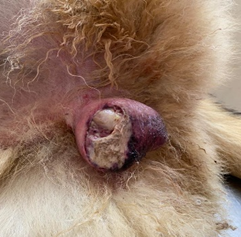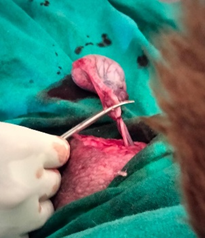Orchitis and Epididymitis in Dogs
- Bhumapati Devi1*, K.Merina Devi2 and T. Gyaneshori Devi3
1*Assistant Professor, Department of Veterinary Gyanecology & Obstetrics, COVSc & AH, Jalukie, Nagaland, India
2Assistant Professor, Department of Livestock Farm Complex, COVSc & AH, Jalukie, Nagaland, India;
3Assistant Professor, Department of Livestock Production Management, COVSc & AH, Jalukie, Nagaland, India
Abstract
Orchitis is an inflammatory condition affecting one or both the testes or testicles. It may be acute or chronic, unilateral or bilateral, however, unilateral case is more common. Causes of epididymitis and orchitis are closely related and can be caused by traumatic injury, infection, torsion, bacteria, virus, fungal agents, scrotal hernia, scrotal dermatitis etc. Infection caused by Brucella canis is a low risk zoonosis except in immunocompromised animals. In acute condition, there is severe pain and infected dog may fall to sick, fever, lethargy, inappetance, doughy scrotum, infertility, excessive licking in inflamed area. Proper diagnostics tools should be carried out to rule out the route cause of infections and adequate treatment must be followed at the earliest. To prevent from orchitis and epididymitis, castration at an early age is the only option.
Keys words: Epididymitis, orchitis, castration
Introduction
Orchitis and epididymitis are occasionally occurring inflammatory conditions in dogs, usually together. Orchitis is an inflammation of either one or both the testes or testicles. It may be unilateral or bilateral, however, unilateral condition is more common. Whereas, epididymitis is the inflammatory condition of the testicular tubes which may occur with or without orchitis. Chronic epididymitis may result to cause reduction in the size of testicles and irregular appearance of the adjacent soft tissues (Troedsson and Dickson, 2020). If both the conditions developed, the condition is very serious and proper and immediate care should to taken (www.wagwalking.com).
Causes of orchitis and epididymitis:
The most common cause is Gram negative bacteria such as E.Coli and most probably by ascending infection (Robert,2017). Other source of causes may include Brucella canis, Staphylococcus, Streptococcus, Proteus and Mycoplasma, Distemper virus, blastomycosis, coccidiomycosis, penetrating trauma to the testicles, testicular torsion granuloma formation, Tick borne diseases (ehrlichiosis and Rocky Mountain spotted fever), agents causing prostatitis, cystitis, neoplasia, scrotal hernia, scrotal dermatitis (Grace, 2015) etc. Infection caused by Brucella canis is a low risk zoonosis except in immunocompromised animals (www.vetlexicon.com).


|
Transmission:
There are several routes of transmission of both the inflammatory conditions which may include hematogenous, veneraeal, penetrating wounds, infections ascending from genitor-urinary passage, prostatic secretions, mucus membranes (Brum, 2015) etc.
Clinical signs and symptoms:
The inflammation may be acute or chronic. In acute condition, there is severe pain and infected dog may fall to sick, fever, lethargy, inappetance, doughy scrotum (Robert, 2017), infertility, excessive licking in inflamed area etc. Most of the bacteria that cause acute orchitis are Brucella canis. In chronic case, it is difficult Infertility to diagnose and also does not show any clinical sign. If the condition is kept unattended there is high chance of causing infertility leading to irreversible damage to the reproductive system.
Diagnosis:
The first and foremost diagnostic test is based on the clinical symptoms. In dog, it is utmost necessary to rule out infection of Brucella canis. Cytological examination of semen for presence of bacteria or mycoplasma should be carried out. Examination on complete blood count (white blood cells, red blood cells and platelets, elevated white blood cells indicate infectious testicular swelling), biochemical blood parameters (blood protein, blood sugar, electrolyte level) can be performed. Ultrasonograpgy examination may revealed the inflammatiory condition. (epididymis, prostrate and testes)- scrotal hernia, neoplasiaor granuloma, Analysis of urine for proteinuria may reveal presence of blood and pus indicating the case of prostatitis or cystitis. Fungal serology titers can be done to detected the fungal causative agents.
Treatment
Castration is the major line of treatment when both the inflammatory conditions occurs in the same animal (Davidson, 2020). If in case only one side of the testes is affected (unilateral), partial castration should be done. But if both the testicles are affected and the dog is not intended for breeding, full castration is generally recommended. During operation intravenous fluid should be provided. Antibiotic, Anti-inflammatory medication should be given. In unilateral involvement, the healthy testis or epididymis should be protected against trauma, heat, swelling etc. (Davidson, 2020).
Prevention and control
Castration at an early age is the only option to prevent occurrence of orchitis and epididymitis. Isolation of the infected animal from the healthy animals, proper maintenance of hygienic conditions in and around the kennel, adequate post operative cares should be followed up. It is advisable to use Elizabethan collar to prevent the dog licking of the incision site.
Conclusion
Orchitis and epididymitis are occasionally occurring disease condition of dogs. There are multiples of causes but concerning about bacterial causes one of the zoonotic organisms is involved. Early and proper diagnosis should be carried out to save the fertility of the animal. Besides these, to prevent from orchitis castration at an early age is the only option.
References:
Braund, K. and Davidson, a.P.Orchitis/epididymis. ISSN: 2398-2969 published in vetlexicon.com
Brum, D.2015.Orchitis (Inflammation of the testicle) in dogs. Published on August 27 in petplace.com.
Davidson, A.P.2020.Reproductive diseases of male dogs and cats. MSD manual,Veterinary Manual.
Epididymtits and Orchitis in dog. https://wagwalking.com/condition/epididymitis-and-orchitis
Grace, P.2015.Testicular swelling in dogs. Published on August 8 in wagwalking.com
Mats H.T. Troedsson, Dickson, D.Varner.2021. Diseases of the reproductive system. Large animal internal medicine, 6th edition. ISBN: 978-0-323-5545-9
Robert,A,F 2017. Male reproductive system. Pathologic basic of veterinary disease (sixth edition)
https://www.pashudhanpraharee.com/infertility-in-dogs/

